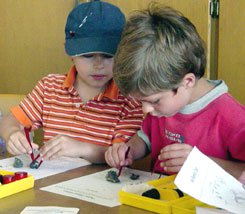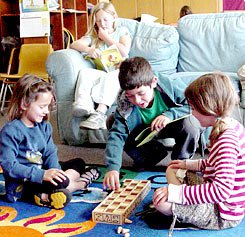Wisdom of the (Multi) Ages: Students Learn by Teaching
Teachers can integrate powerful lessons from the multiage classroom into their single-grade classroom.
Your content has been saved!
Go to My Saved Content.
The kindergartners tend to ramble and mumble. The second graders are more concise. Each student mentions something they are grateful for as they pass a heart-shaped rock, warmed by many little hands, around the circle in a multiage class at Pine Crest School, in Sebastopol, California.
Near the end of the circle, as the students are starting to fidget, a smallish kindergartner named Aidan begins to regale the group with his video game conquests. The tall second grader seated next to him, Everest, stage-whispers in his ear, "Don't tell a long story. Just do your appreciation, or it will take too much time." Aidan wraps it up quickly.
This is the essence of the multiage classroom: Older students model good behavior and, through continual peer mentoring, stretch their teaching muscles and solidify their own knowledge. And the younger students learn that teachers aren't the only ones who know a thing or two. "I haven't had a student yet who, even six years later, didn't remember whom they helped and who helped them," says teacher Terence Rodgers about the mentoring process. "Really, it's pretty magical."
A Class That's Like a Family
The multiage classroom (the system is also called looping) contains students of different ages and grade levels who stay with the same teacher for several years. In the case of Pine Crest, the classes are K-2 and 3-5. The students learn predominantly in small, heterogeneous groups, and parents often come to class to help lead them. The system provides teachers with a three-year span to get to know their students' strengths and weaknesses and to support the individual growth of each student. Over the years, the class develops into something like a family.

Although the multiage classroom is a rarity in the United States (and getting rarer still as high-stakes testing has taken hold) and requires a special kind of teacher, it offers many lessons adaptable to the traditional classroom -- in particular, student-to-student mentoring.
A landmark study published in June 2007 revealed that older siblings have higher IQ scores than their younger siblings. The cause is not biological, but a result of the interplay between parents and children and the children themselves. In a New York Times article, Robert Zajonc, a psychologist at Stanford University, said he believes the tutoring older siblings give to their younger brothers and sisters has a positive impact on the intelligence of the older children.
"Explaining something to a younger sibling solidifies your knowledge and allows you to grow more extensively," he added. "The younger one is asking questions and challenging meanings and explanations, and that will contribute to the intellectual maturity of the older one."
How to Create a Student-Mentoring Environment
Russell Yates, educational-programming director at the Swan School, in Port Townsend, Washington, and multiage teacher for grades 3-4, offers the following guidelines on how to get students to mentor each other successfully in your class:
- Teach students that helping others learn does not mean just giving them the answer. Facilitate good tutoring by modeling effective methods and allowing students to practice them.
- All students, not just those the teacher views as capable or who have high test scores, should have the opportunity to be a peer mentor.
- Consider buddying up your class with another, probably younger, single-grade class for peer mentoring.
- Small-group peer mentoring can take on the form of a jigsaw puzzle, in which the teacher gives an assignment with multiple parts, and each student in the group learns a part and then teaches it to the other students.
- In small-group learning, employ the three-before-me rule: Students must check with three classmates before raising a hand to ask for help from the teacher. This approach gives every student the chance to help instruct.
- Small-group learning can get loud. To keep the noise level reasonable, check out these tips from Multiage-Education.com on helping young students learn to control their voices. Also, print out and post the site's noise-meter poster -- a visual reminder about appropriate voice levels -- or create your own version.
- Peer mentoring should be frequent enough to develop routines but not so often that students lose enthusiasm for it. Once a week is a good start.
- Use peer mentoring as a chance to support the development of leadership skills among all students. A student who struggles with reading and writing but excels in art could probably benefit from a self-confidence boost. On an art project, pair this student up with a peer who excels in the core subjects.
- By creating a situation that benefits all students, you'll make the mentoring experience genuine. When pairing students, think about their strengths and weaknesses and be sure the exercise will benefit both parties.
- Simply having students read to one another isn't as powerful as having them teach each other a discrete skill.
Anda, one of Yates's students, comments on her mentoring experience: "When I am helping other people, I start by showing them how I did it. I do what Russ does. I ask them a question about a part of the problem. They tell me the answer, and I write it down for them on the first and maybe the second section of the problem. Then, they do it all for themselves. If they don't get it, Russ takes over."
Molly Jackel is a freelance writer and editor. She lives in Sebastopol, California.
Multiage Mentoring: Resources for Collaboration Across Grade Levels
To learn more about multiage education and how to use its principles and activities in your classroom, visit these sites:
- Multiage-Education.com, Russell Yates's well-written, classroom-proven, encyclopedic site on all things multiage, includes examples, printable graphics, assessment tools, links, and more.
- If you're setting up a multiage class or just want to use some of the ideas, go to Choosing Multiage, which features easy-to-follow presentations (in PDF format) on handling the various challenges you'll face.
- Ms. T., Inc.: Meaningful Strategies for Teachers provides downloadable exercises you can use in any elementary school classroom.
- Teaching Math in the Multi-Age Classroom offers tips on establishing small classroom groups for learning math, and offers links to many more math sites.
-- MJ